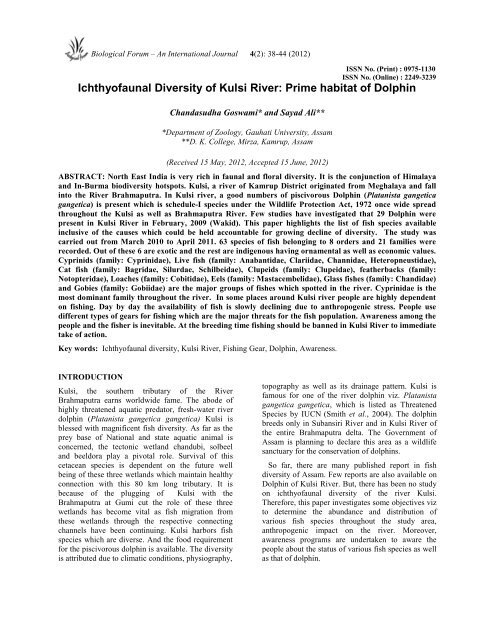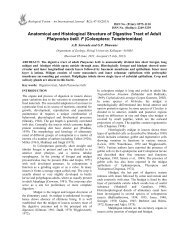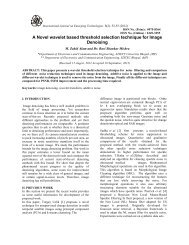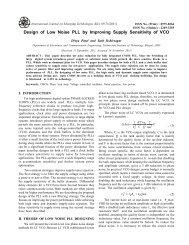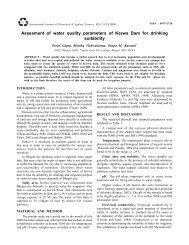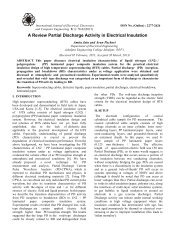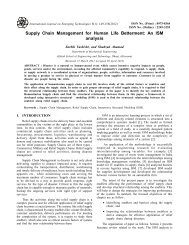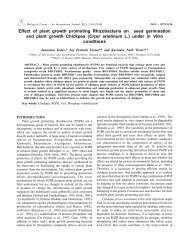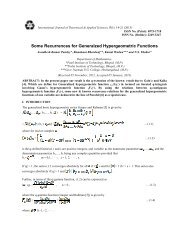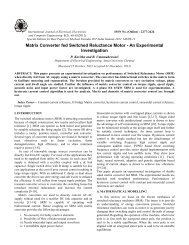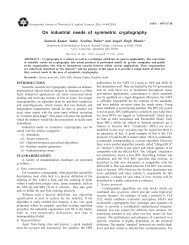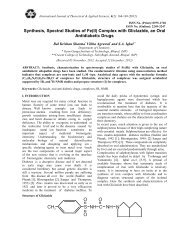Ichthyofaunal Diversity of Kulsi River - Researchtrend.net
Ichthyofaunal Diversity of Kulsi River - Researchtrend.net
Ichthyofaunal Diversity of Kulsi River - Researchtrend.net
Create successful ePaper yourself
Turn your PDF publications into a flip-book with our unique Google optimized e-Paper software.
Biological Forum – An International Journal 4(2): 38-44 (2012)<br />
ISSN No. (Print) : 0975-1130<br />
ISSN No. (Online) : 2249-3239<br />
<strong>Ichthy<strong>of</strong>aunal</strong> <strong>Diversity</strong> <strong>of</strong> <strong>Kulsi</strong> <strong>River</strong>: Prime habitat <strong>of</strong> Dolphin<br />
Chandasudha Goswami* and Sayad Ali**<br />
*Department <strong>of</strong> Zoology, Gauhati University, Assam<br />
**D. K. College, Mirza, Kamrup, Assam<br />
(Received 15 May, 2012, Accepted 15 June, 2012)<br />
ABSTRACT: North East India is very rich in faunal and floral diversity. It is the conjunction <strong>of</strong> Himalaya<br />
and In-Burma biodiversity hotspots. <strong>Kulsi</strong>, a river <strong>of</strong> Kamrup District originated from Meghalaya and fall<br />
into the <strong>River</strong> Brahmaputra. In <strong>Kulsi</strong> river, a good numbers <strong>of</strong> piscivorous Dolphin ( Platanista gangetica<br />
gangetica) is present which is schedule-I species under the Wildlife Protection Act, 1972 once wide spread<br />
throughout the <strong>Kulsi</strong> as well as Brahmaputra <strong>River</strong>. Few studies have investigated that 29 Dolphin were<br />
present in <strong>Kulsi</strong> <strong>River</strong> in February, 2009 (Wakid). This paper highlights the list <strong>of</strong> fish species available<br />
inclusive <strong>of</strong> the causes which could be held accountable for growing decline <strong>of</strong> diversity. The study was<br />
carried out from March 2010 to April 2011. 63 species <strong>of</strong> fish belonging to 8 orders and 21 families were<br />
recorded. Out <strong>of</strong> these 6 are exotic and the rest are indigenous having ornamental as well as economic values.<br />
Cyprinids (family: Cyprinidae), Live fish (family: Anabantidae, Clariidae, Channidae, Heteropneustidae),<br />
Cat fish (family: Bagridae, Silurdae, Schilbeidae), Clupeids (f amily: Clupeidae), featherbacks (family:<br />
Notopteridae), Loaches (family: Cobitidae), Eels (family: Mastacembelidae), Glass fishes (family: Chandidae)<br />
and Gobies (family: Gobiidae) are the major groups <strong>of</strong> fishes which spotted in the river. Cyprinidae is the<br />
most dominant family throughout the river. In some places around <strong>Kulsi</strong> river people are highly dependent<br />
on fishing. Day by day the availability <strong>of</strong> fish is slowly declining due to anthropogenic stress. People use<br />
different types <strong>of</strong> gears for fishing which are the major threats for the fish population. Awareness among the<br />
people and the fisher is inevitable. At the breeding time fishing should be banned in <strong>Kulsi</strong> <strong>River</strong> to immediate<br />
take <strong>of</strong> action.<br />
Key words: <strong>Ichthy<strong>of</strong>aunal</strong> diversity, <strong>Kulsi</strong> <strong>River</strong>, Fishing Gear, Dolphin, Awareness.<br />
INTRODUCTION<br />
<strong>Kulsi</strong>, the southern tributary <strong>of</strong> the <strong>River</strong><br />
Brahmaputra earns worldwide fame. The abode <strong>of</strong><br />
highly threatened aquatic predator, fresh-water river<br />
dolphin ( Platanista gangetica gangetica) <strong>Kulsi</strong> is<br />
blessed with magnificent fish diversity. As far as the<br />
prey base <strong>of</strong> National and state aquatic animal is<br />
concerned, the tectonic wetland chandubi, solbeel<br />
and beeldora play a pivotal role. Survival <strong>of</strong> this<br />
cetacean species is dependent on the future well<br />
being <strong>of</strong> these three wetlands which maintain healthy<br />
connection with this 80 km long tributary. It is<br />
because <strong>of</strong> the plugging <strong>of</strong> <strong>Kulsi</strong> with the<br />
Brahmaputra at Gumi cut the role <strong>of</strong> these three<br />
wetlands has become vital as fish migration from<br />
these wetlands through the respective connecting<br />
channels have been continuing. <strong>Kulsi</strong> harbors fish<br />
species which are diverse. And the food requirement<br />
for the piscivorous dolphin is available. The diversity<br />
is attributed due to climatic conditions, physiography,<br />
topography as well as its drainage pattern. <strong>Kulsi</strong> is<br />
famous for one <strong>of</strong> the river dolphin viz. Platanista<br />
gangetica gangetica, which is listed as Threatened<br />
Species by IUCN (Smith et al., 2004). The dolphin<br />
breeds only in Subansiri <strong>River</strong> and in <strong>Kulsi</strong> <strong>River</strong> <strong>of</strong><br />
the entire Brahmaputra delta. The Government <strong>of</strong><br />
Assam is planning to declare this area as a wildlife<br />
sanctuary for the conservation <strong>of</strong> dolphins.<br />
So far, there are many published report in fish<br />
diversity <strong>of</strong> Assam. Few reports are also available on<br />
Dolphin <strong>of</strong> <strong>Kulsi</strong> <strong>River</strong>. But, there has been no study<br />
on ichthy<strong>of</strong>aunal diversity <strong>of</strong> the river <strong>Kulsi</strong>.<br />
Therefore, this paper investigates some objectives viz<br />
to determine the abundance and distribution <strong>of</strong><br />
various fish species throughout the study area,<br />
anthropogenic impact on the river. Moreover,<br />
awareness programs are undertaken to aware the<br />
people about the status <strong>of</strong> various fish species as well<br />
as that <strong>of</strong> dolphin.
Goswami and Ali 39<br />
MATERIALS AND METHODS<br />
Study Area<br />
<strong>Kulsi</strong> river is <strong>of</strong> total length 80 km from Meghalaya.<br />
The Geographical coordinates <strong>of</strong> Meghalaya are<br />
25 0 38 ′ N, 91 0 38 ′ E (Wakid and Braulik, 2009), to<br />
Nagarbera (Fig 1). But our study area is <strong>of</strong> 76km<br />
exclusive <strong>of</strong> the Maghalayan segment.<br />
For convenience <strong>of</strong> study the river is divided into<br />
three segments- (a) from <strong>Kulsi</strong> to Kukurmara, (b)<br />
from Kukurmara to Nagarbera, (c) Jaljali (kulsi -<br />
Brahmaputra confluence) at Nagarbera where <strong>Kulsi</strong><br />
decharges to the <strong>River</strong> Brahmaputra.<br />
Fig. 1. Map <strong>of</strong> Study area.
Goswami and Ali 40<br />
Sampling<br />
The study area <strong>of</strong> 76km contains 3 prominent<br />
bifurcation commonly known as ‘dumukh’ at <strong>Kulsi</strong><br />
(village), Kukurmara and Jaljali (Nagarbera). These 3<br />
sample points were choosen in order to cover all<br />
areas and habitat types. Sampling records were taken<br />
fortnightly from March 2010 to April 2011. Common<br />
fishes were recorded at landing sites and a sample<br />
collection was made for certain species for further<br />
laboratory confirmation.<br />
Survey Method<br />
Specimens were either collected from landing site or<br />
on the river by using various gears (<strong>net</strong>s, hooks etc),<br />
hand pricking etc. Landing sites were monitored at<br />
intervals for the stipulated period, covering premonsoon,<br />
monsoon and post-monsoon seasons. For<br />
identification and classification <strong>of</strong> various fish<br />
species Talwar & Jhingran (1991) and Jayaram<br />
(1999) were referred. These specimens were<br />
preserved in formalin. In addition, the nearby<br />
fishermen communities have been interviewed; as<br />
well as gears and methods used for capturing fishes<br />
were recorded.<br />
RESULTS<br />
About 4579 individuals were collected from the river<br />
within the study period. A total <strong>of</strong> 63 fish species<br />
(Table 1), that belongs to 8 orders and 21 families<br />
were recorded. Out <strong>of</strong> these, 6 are exotic (Table 2)<br />
and the rest are indigenous having ornamental as well<br />
as economic values.<br />
Table 1: Ichthyologic <strong>Diversity</strong> <strong>of</strong> <strong>Kulsi</strong> <strong>River</strong>.<br />
Assamese Name Scientific Name Order Family Status A<br />
Arii Aorichthys seenghala Siluriformes Bagridae A<br />
Arii Aorichthys aor Siluriformes Bagridae A<br />
Balibotia Noemacheilus botia Cypriniformes Balitoridae LA<br />
Bami<br />
Mastacembalus armatus Synbranchiformes Mastacembelidae MA<br />
armatus<br />
Barali Wallago attu Siluriformes Siluridae A<br />
Bhakua/Bahu Catla catla Cypriniformes Cyprinidae MA<br />
Bhangone/ Nara Labeo bata Cypriniformes Cyprinidae MA<br />
Boolla Barilius tileo Cypriniformes Cyprinidae R<br />
Botia Botia dario Cypriniformes Cobitidae MA<br />
Chanda Chanda nama Perciformes Ambassidae MA<br />
Cheng garaka Channa barca Perciformes Channidae MA<br />
Cheniputhi Puntius sarana sarana Cypriniformes Cyprinidae R<br />
Chital Notopterus chitala Osteoglossiformes Notopteridae R<br />
Darikana Esomus danricus Cypriniformes Cyprinidae A<br />
Darikana Rasbora daniconius Cypriniformes Cyprinidae A<br />
Darikana Rasbora bonensis Cypriniformes Cyprinidae A<br />
Darikana Rasbora rasbora Cypriniformes Cyprinidae A
Table 1 cont…<br />
Goswami and Ali 41<br />
Eleng Rasbora elanga Cypriniformes Cyprinidae R<br />
Gagol Mystus menoda Siluriformes Bagridae R<br />
Gangatope Tetradon kutkutia Tetradontiformes Tetradontidae R<br />
Gedgedi/ Bhetki/<br />
Nandus nandus Perciformes Nandidae LA<br />
Khaloibhangi<br />
Gethu Botia histrionica Cypriniformes Cobitidae R<br />
Goroi Channa punctatus Perciformes Channidae A<br />
Ilish Hilsa ilisha Clupeiformes Clupeidae R<br />
Kadali/BapatiBardaia Ailia coila Siluriformes Schilbeidae R<br />
Kandhuli Notopterus notopterus Osteoglossiformes Notopteridae A<br />
Karoti Gudusia variegata Clupeiformes Clupeidae A<br />
Kholihona Ctenops nobilis Perciformes Osphronemidae A<br />
Kholihona Colisa fasciata Perciformes Belontiidae A<br />
Kokila Xenentodon cancila Beloniformes Belonidae R<br />
Kuchia/ Cuchia Amphipnous cuchia Synbranchiformes Synbranchidae MA<br />
Kurhi Labeo gonius Cypriniformes Cyprinidae LA<br />
Laupati Danio devario Cypriniformes Cyprinidae LA<br />
Magur Clarias magur Siluriformes Clariidae MA<br />
Mali/ Kaliajora Labeo calbasu Cypriniformes Cyprinidae MA<br />
Mirika Cirrhinus mrigala Cypriniformes Cyprinidae A<br />
Moa Ambiypharyngodon mola Cypriniformes Cyprinidae A<br />
Nandani/ Nadani Labeo nandina Cypriniformes Cyprinidae R<br />
Neria Clupisoma garua Siluriformes Schilbeidae MA<br />
Pabhoh Ompok pabo Siluriformes Siluridae R<br />
Pabhoh Ompok pabda Siluriformes Siluridae R<br />
Pabhoh Ompok bimaculatus Siluriformes Siluridae LA<br />
Panimutura Glossogobius giuris Perciformes Gobiidae A<br />
Puthi Puntius sophore Cypriniformes Cyprinidae A<br />
Puthi Puntius conchonius Cypriniformes Cyprinidae A<br />
Puthi/ Kenipotiah Puntius ticto Cypriniformes Cyprinidae A<br />
Rashim/ Lachim/ Laseem Cirrhinus reba Cypriniformes Cyprinidae MA<br />
Rau Labeo rohita Cypriniformes Cyprinidae MA<br />
Ritha Rita rita Siluriformes Bagridae LA<br />
Sal Channa marulius Perciformes Channidae MA
Goswami and Ali 42<br />
Table 1 cont…<br />
Silgharia Labeo dero Cypriniformes Cyprinidae LA<br />
Silgharia Labeo dyocheilus Cypriniformes Cyprinidae MA<br />
Singhi Heteropneustus fossilis Siluriformes Heteropneustedae LA<br />
Tingorah Mystus tengara Siluriformes Bagridae A<br />
Tingorah/Singorah Mystus vittatus Siluriformes Bagridae R<br />
Turi Macrognathus aral Synbranchiformes Mastacembelidae LA<br />
A A- Abundant, MA- Moderately Abundant, LA- Less Abundant, R- Rare<br />
Table 2: Exotic Fish <strong>Diversity</strong> <strong>of</strong> <strong>Kulsi</strong> <strong>River</strong>.<br />
Common Name Scientific Name Order Family Status<br />
Common carp Cyprinus carpio Cypriniformes Cyprinidae A<br />
Grass carp Ctenopharyngodon idella Cypriniformes Cyprinidae A<br />
Silver carp Hypophthalmichthys molitrix Cypriniformes Cyprinidae A<br />
Big head carp Hypophthalmichthys nobilis Cypriniformes Cyprinidae A<br />
Thiland magur Clarias garripinius Siluriformes Clariidae A<br />
Japani kawai Oreochromis mossambica Perciformes Cichlidae A<br />
Details <strong>of</strong> the species recorded from the Study<br />
Area<br />
1) Order: Beloniformes (1 family, 1sp)<br />
Family: Belonidae (1 sp.)<br />
Xenentodon cancila ( Hamilton, 1822)<br />
2) Order: Clupeiformes (1 family, 2spp.)<br />
Family: Clupeidae (2 spp.)<br />
Hilsa ilisa<br />
Gudusia variegate (Day, 1870)<br />
3) Order: Cypriniformes (3 families, 29spp)<br />
Family: Balitoridae (1 sp)<br />
Noemacheilus botia (Hamilton, 1822)<br />
Family: Cobitidae (2 spp)<br />
Botia Dario (Hamilton, 1822)<br />
Botia histrionic (Blyth, 1860)<br />
Family: Cyprinidae (26 spp)<br />
Catla catla (Hamilton, 1822)<br />
Labeo bata (Hamilton, 1822)<br />
Puntius sarana sarana (Hamilton, 1822)<br />
Esomus danricus (Hamilton, 1822)<br />
Rasbora daniconius (Hamilton, 1822)<br />
Rasbora bonensis (Hamilton, 1822)<br />
Rasbora rasbora (Hamilton, 1822)<br />
Labeo gonius (Hamilton, 1822)<br />
Danio devario (Hamilton, 1822)<br />
Labeo calbasu (Hamilton, 1822)<br />
Cirrhinus cirrhosus (Bloch, 1795)<br />
Ambiypharyngodon mola (Hamilton, 1822)<br />
Puntius sophore (Hamilton, 1822)<br />
Pethia conchonia (Hamilton, 1822)<br />
Pethia ticto (Hamilton, 1822)<br />
Labeo rohita (Hamilton, 1822)<br />
Labeo dero (Hamilton, 1822)<br />
Labeo dyocheilus (McClelland, 1839)<br />
Barilius tileo (Hamilton, 1822)<br />
Rasbora elanga (Hamilton, 1822)<br />
Labeo nandina (Hamilton, 1822)<br />
Cirrhinus reba (Hamilton, 1822)<br />
Cyprinus carpio (Linnaeus, 1758)<br />
Ctenopharyngodon idella (Valenciennes, 1844)<br />
Hypophthalmichthys molitrix (Valenciennes, 1844)<br />
Hypophthalmichthys nobilis (J. Richardson, 1845)<br />
4) Order: Osteoglossiformes (1 family, 2spp)<br />
Family: Notopteridae (2 spp)<br />
Chitala chitala (Hamilton, 1822))<br />
Notopterus notopterus (Pallas, 1769)<br />
5) Order: Perciformes (8 families, 10spp)<br />
Family: Ambassidae (1 sp)<br />
Chanda nama (Hamilton, 1822)<br />
Family: Anabantidae (1 sp)<br />
Anabas testudineus (Bloch, 1792)<br />
Family: Belontiidae (1 sp)<br />
Colisa fasciata (Bloch and Schneider, 1801)<br />
Family: Channidae (3 spp)<br />
Channa barca (Hamilton, 1822)<br />
Channa marulius (Hamilton, 1822)
Goswami and Ali 43<br />
6) Order: Siluriformes (5 families, 15spp)<br />
Family: Bagridae (6 spp)<br />
Rita rita (Hamilton, 1822)<br />
Aorichthys seenghala (Sykes, 1841)<br />
Sperata aor (Hamilton, 1822)<br />
Hemibagrus menoda (Hamilton, 1822)<br />
Mystus tengara (Hamilton, 1822)<br />
Mystus vittatus (Bloch , 1794)<br />
Family: Clariidae (2 spp)<br />
Clarias magur (Hamilton, 1822)<br />
Clarias magur (Common name: Thailand magur)<br />
Family: Schilbeidae (2 spp)<br />
Ailia coila (Hamilton, 1822)<br />
Clupisoma garua (Hamilton, 1822)<br />
Family: Siluridae (4 spp)<br />
Wallago attu (Bloch & J. G. Schneider, 1801)<br />
Ompok pabo (Hamilton, 1822)<br />
Ompok pabda (Hamilton, 1822)<br />
Ompok bimaculatus (Bloch , 1794)<br />
Family: Heteropneustedae (1 sp)<br />
Heteropneustus fossilis (Bloch , 1794)<br />
7) Order: Synbranchiformes (1 family, 3 spp)<br />
Family: Mastacembelidae (3 spp)<br />
Mastacembalus armatus armatus (Lacepède, 1800)<br />
Macrognathus aral (Bloch and Schneider, 1801)<br />
Amphipnous cuchia (Hamilton, 1822))<br />
8) Order: Tetradontiformes (1 family, 1sp)<br />
Family: Tetradontidae (1sp)<br />
Tetradon kutkutia (Hamilton, 1822).<br />
Channa punctatus (Bloch, 1792)<br />
Family: Cichlidae (1 sp)<br />
Oreochromis mossambica (Peters)<br />
Family: Gobiidae (1 sp)<br />
Glossogobius giuris (Hamilton, 1822)<br />
Family: Nandidae (1 sp)<br />
Nandus nandus (Hamilton, 1822)<br />
Family: Osphronemidae (1 sp)<br />
Ctenops nobilis (McClelland, 1845)<br />
Cypriniformes is the most dominant group<br />
throughout the river (29 species) and Cyprinidae is<br />
the most species rich family (26 species). Puntius<br />
sophore is the most dominant species in kukurmara<br />
and kulsi village whereas Wallago attu density is<br />
highest at nagarbera. Nagarbera harbor mainly large<br />
fishes, in turn in kukurmara small fish population is<br />
abundant.<br />
Effect <strong>of</strong> Anthropogenic stress on the river<br />
It is said that wetlands are more precious than trees to<br />
maintain global warming.<br />
These are the heart <strong>of</strong> rivers. <strong>Kulsi</strong> is surrounded by a<br />
number <strong>of</strong> wetlands viz. <strong>Kulsi</strong>, Dorabeel,<br />
Kukurmara, Salsola, Barpith, Baweli, Chandubi etc<br />
which are now at deteriorating state.<br />
The nearby fishers do some plantation like<br />
paddy, banana, areca-nuts, vegetables etc. to live life.<br />
As the neighboring area is a flood prone area hence<br />
paddy cultivation is not pr<strong>of</strong>itable. With the<br />
emergence <strong>of</strong> Chinese cultivation, problem is solved<br />
to some extent. But it affects the river. Again, one <strong>of</strong><br />
the characteristic features <strong>of</strong> the river is water level <strong>of</strong><br />
the river fluctuates depending mainly on rainfall in<br />
Meghalaya, not that <strong>of</strong> Assam.<br />
Moreover, another major anthropogenic<br />
stress is industrialization. Hand some <strong>of</strong> people set<br />
up industry in the nearby wetlands e.g. brick industry<br />
in kukurmara ghat, on dora beel about 200 bigha land<br />
is occupied to construct a distillery industry. This<br />
physical habitat loss/degradation is one <strong>of</strong> the threats<br />
to indigenous fish diversity.<br />
Heavy sand mining is also affecting the<br />
river resource a lot. In <strong>Kulsi</strong> <strong>River</strong>, as depth is low,<br />
hence sand mining up to a limit is necessary. But<br />
mining above threshold value stressed thereby<br />
population. Henceforth, it is beneficial and at the<br />
same time limiting factor for conservation and<br />
biodiversity.<br />
Other threats are over exploitation, siltation<br />
(God & Goddess <strong>of</strong> Durga puja are thrown in the<br />
<strong>Kulsi</strong> <strong>River</strong>), destruction <strong>of</strong> outlet (gumi -cut) etc.<br />
Moreover, other anthropogenic stresses are over<br />
fishing, entry <strong>of</strong> exotic species, ignorance <strong>of</strong><br />
fishermen etc. While the eco-tourism venture is<br />
gaining momentum at various potential sites <strong>of</strong> the<br />
fishes, in turn in kukurmara small fish population is<br />
abundant. This may be due to over fishing at<br />
kukurmara. Over fishing is also going on at<br />
nagarbera. But area <strong>of</strong> nagarbera is much larger in<br />
comparison to fishing community. Hence nagarbera<br />
is not affected. The highest numbers <strong>of</strong> varieties<br />
were obtained at Nagarbera (63 species). People <strong>of</strong><br />
Nagarbera also used maximum varieties <strong>of</strong> fishing<br />
gears. As the abundance <strong>of</strong> fish is high, hand<br />
pricking <strong>of</strong> fish is also done and proved as a fruitful<br />
method. Various <strong>net</strong>ting operation is done<br />
throughout the river. The main gears used are hook,<br />
line, <strong>net</strong> (Cast <strong>net</strong>, Gill <strong>net</strong> etc) Bamboo basket,<br />
Bamboo trap, duruk, dingora, chalani, etc. Nets are<br />
known among the local community as asra jal, lungi<br />
jal, jata jal, ghoka jal, mohori jal, boital, etc.
Goswami and Ali 44<br />
<strong>Kulsi</strong> river which is blessed with enormous tourism<br />
prospects, but yet to be fully exploited. Of the 72-km<br />
stretch from Ghoramara to Nagarbera, the<br />
downstream confluences <strong>of</strong> two wetlands – Sal and<br />
Beeldora posses highest fish density coupled with<br />
adequate depth <strong>of</strong> the river. In addition to these, now<br />
‘<strong>Kulsi</strong> multipurpose project’ is proposed to have a 42<br />
m high dam with installed capacity <strong>of</strong> 29 MW by<br />
Brahmaputra board, ministry <strong>of</strong> water resource. The<br />
<strong>Kulsi</strong> Multipurpose Project envisages construction <strong>of</strong><br />
an earthen dam across the river <strong>Kulsi</strong> at about 1.5 km<br />
down stream <strong>of</strong> Umkium village in Assam. This dam<br />
construction will destroy all the resources including<br />
dolphin and fish <strong>of</strong> the river.<br />
Conservation<br />
Maintaining ichthyodiversity is too essential as it is<br />
not always possible to identify which individual<br />
species are critical to aquatic ecosystem’s<br />
sustainability. Conservation programmes catalize fish<br />
production to be more sustainable and also maintain<br />
diversity. <strong>Diversity</strong> facilitates production by full<br />
utilization <strong>of</strong> the resource, encourage recovery from<br />
disturbance as well as decrease disease problem.<br />
Conservation may be practiced as in-situ or ex-situ.<br />
Govt <strong>of</strong> Assam if declare this area as a wildlife<br />
sanctuary for the conservation <strong>of</strong> dolphins that will<br />
be a great step conserve the recourses available on<br />
the river. On the other hand, dam construction will<br />
lead to the reverse situation. We have organized three<br />
awareness programmes to aware the people about the<br />
status <strong>of</strong> various fish species as well as that <strong>of</strong><br />
dolphin and also to evoke the sense <strong>of</strong> people about<br />
the present ecological condition.<br />
DISCUSSION<br />
Though <strong>Kulsi</strong> river harbor various fish species in<br />
addition with Ganges river dolphin, Platanista<br />
gangetica (Roxburgh), but the society is not aware<br />
enough about it. Jayachandran et al. describes that the<br />
ecology <strong>of</strong> the river consisted <strong>of</strong> temperature<br />
fluctuating widely from 15 to 28 1C, depth from 0.8<br />
to 10 m, turbidity <strong>of</strong> 11–19 cm, sand mining @<br />
12,500MT annually, and fish catch <strong>of</strong> 300–800 kg<br />
(from 1.5km area). All these factors pose a great<br />
threat to the fish and prawn wealth <strong>of</strong> the river<br />
(Jayachandran et al., 2006). Biswas & Baruah (2000)<br />
investigated the habitat ecology <strong>of</strong> the Gangetic<br />
dolphin in the Brahmaputra river stretch within<br />
Eastern Assam and Bairagi (1999) reported the<br />
impact <strong>of</strong> the oil bait fishery on the dolphins <strong>of</strong><br />
Brahmaputra <strong>River</strong>.<br />
CONCLUSION<br />
<strong>Kulsi</strong> is bestowed with immense resources <strong>of</strong> Nature.<br />
The fish diversity has suffered a lot due to heavy<br />
anthropogenic stress. What matters more at this hour<br />
are the well plan conservative measures to be<br />
undertaken to stem the rot-the alarming decline <strong>of</strong><br />
fish diversity. Particularly the loaches fish including<br />
the commercial fish species which are the be all and<br />
end all both <strong>of</strong> the dolphin and the fisher.<br />
ACKNOWLEDGEMENTS<br />
We want to <strong>of</strong>fer thanks to the nearby fishing<br />
community <strong>of</strong> kukurmara, kulsi and people <strong>of</strong><br />
Dhanabari,baonapata, rangaswari, paharpara,<br />
vagaridia etc ( nagarbera) for provoding us local<br />
knowledge and information about the river as well as<br />
<strong>of</strong> fish species. We also want to extend deep sence <strong>of</strong><br />
gratitude to Pr<strong>of</strong>. U. C. Goswami <strong>of</strong> Gauhati<br />
University for his support and guidance during the<br />
study. We are also thankful to Debojit Choudhury<br />
and Karuna Baishya for the information and<br />
arrangements that they provided.<br />
REFERENCES<br />
Smith, B.D., Braulik, G. & Sinha, R.K., (2004).<br />
IUCN Red List <strong>of</strong> Threatened Species.<br />
Version 2010.4.<br />
Bairagi, S.P., (1999). Oil bait fishery <strong>of</strong> catfishes in<br />
Brahmaputra <strong>River</strong> affecting river dolphin<br />
populations in Assam, India. Journal <strong>of</strong> the<br />
Bombay Natural History Societ., 96: 424-426.<br />
Biswas, S. P. and S. Baruah, (2000). Ecology <strong>of</strong> river<br />
dolphin (Platanista gangetica) in the Upper<br />
Brahmaputra. Hydrobiologia, 430: 97 – 111.<br />
Jayachandran K.V., Mohan R.S. Lal, Raji A.V.,<br />
(2006). A new species <strong>of</strong> Macrobrachium<br />
Bate, 1868 (Decapoda, Palaemonidae) from<br />
the dolphin trenches <strong>of</strong> <strong>Kulsi</strong> <strong>River</strong>, N. India,<br />
possibly under threat.<br />
Jayaram, K.C., (1999). The fresh water fish <strong>of</strong> the<br />
Indian region.<br />
Jhingran, V.G., (1991). Fis h and Fisheries <strong>of</strong> India.<br />
Third edition.<br />
Wakid, A. And Braulik, G., (2009), Protection <strong>of</strong><br />
endangered Ganges <strong>River</strong> dolphins in the<br />
Brahmaputra <strong>River</strong>, Assam, India, Final<br />
report to IUCN-Sir Peter Scott Fund, Rue<br />
Mauverney 28, 1196 Gland, Switzerland.


